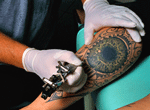Technology innovation—sometimes it's great, sometimes it seems like someone is pulling your leg. In this case, almost literally.
UnwiredView.com ran a story last week about a Nokia patent filing that it calls "borderline creepy," involving haptic technology and tattoos. Haptic technology, as described in the patent, "is a tactile feedback technology that takes advantage of a user's sense of touch by applying forces, vibrations, and/or motions to the user."
According to the story, Nokia's patent is "proposing the application of tattoos with ferromagnetic inks, that will vibrate based on commands from your phone."
The UnwiredView story shows the tattoo on a person's stomach. That might make sense for a certain demographic, but not one that I'm a member of. The story, which describes a bit more about the tattooing process for those interested, also speculates about the situations in which such a tattoo might be useful:
"There probably are some valid use cases for something like this. For example, in noisy environments when you risk not hearing your phone, this tech would make sure you know it is ringing. Or even at the exact opposite end of the spectrum, it could prove useful in very quiet situations, where even a phone set to vibrate can be heard and can be disturbing. Although with this use case we are already plunging into creepy territory."
The Nokia patent also says that:
"User sensing the ferromagnetic image may receive different perceivable stimulus via the ferromagnetic depending on the segmented area, where the magnetic field originated. Different segmented areas may be configured to output to the user different, distinguishable functions or features remotely via haptic stimulus. "
Apparently, this means that you could tell not only whether your were receiving a phone call, but a text message, and from whom.
Perhaps the military would be interested. Right now pilots and troops in combat get bombarded with visual and audible clues about threats which can easily overload (pdf) them to a point where they begin to lose situational awareness. Maybe some of that can be offloaded to the body.
The patent suggests some other uses as well:
"Another technical effect of one or more of the example embodiments is to provide potential for security applications and passwords which might be required in interaction with different electronic communication devices for example but not limited to lap tops, desk tops, mobile phones, gaming devices, personal digital assistants, internet tablets."
I can picture a version of the security systems that requires you to look at LCD screen and type in the code they see--except in this case, you would type, say, the long and short pulses (Morse code lives another day!) that the phone transmits to your stomach or leg.
Okay, let your own imagination roam—where else would this be useful? Meanwhile, I have a couple of questions. Could a hacker send you messages that cause painful cramps? And has Nokia tested the technology to see what happens at airport security gates?
Photo: Microsoft
Robert N. Charette is a Contributing Editor to IEEE Spectrum and an acknowledged international authority on information technology and systems risk management. A self-described “risk ecologist,” he is interested in the intersections of business, political, technological, and societal risks. Charette is an award-winning author of multiple books and numerous articles on the subjects of risk management, project and program management, innovation, and entrepreneurship. A Life Senior Member of the IEEE, Charette was a recipient of the IEEE Computer Society’s Golden Core Award in 2008.



